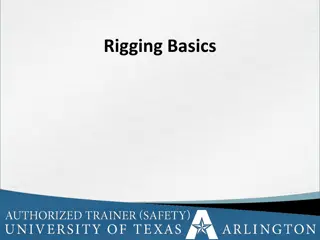Oil and Gas Industry Hazards and Control Measures
Learn to mitigate fire, explosion, exposure, physical hazards, falls, transportation risks, and natural hazards in the oil and gas sector. Effective control measures reduce risks and ensure worker safety. Explore key safety protocols.
Download Presentation

Please find below an Image/Link to download the presentation.
The content on the website is provided AS IS for your information and personal use only. It may not be sold, licensed, or shared on other websites without obtaining consent from the author.If you encounter any issues during the download, it is possible that the publisher has removed the file from their server.
You are allowed to download the files provided on this website for personal or commercial use, subject to the condition that they are used lawfully. All files are the property of their respective owners.
The content on the website is provided AS IS for your information and personal use only. It may not be sold, licensed, or shared on other websites without obtaining consent from the author.
E N D
Presentation Transcript
Oil and Gas Industry Hazards and Control Measures www.hsestudyguide.com
Oil and Gas Industry The oil and gas industry comes with various hazards, but implementing proper control measures can significantly reduce risks. Here are some common hazards and corresponding control measures: www.hsestudyguide.com
Fire and Explosions: Hazard:Highly flammable substances like oil and gas can lead to fires and explosions. Control Measures:Regular equipment inspections, proper training on handling flammable materials, installation of fire detection systems, and emergency response planning. www.hsestudyguide.com
Exposure to Harmful Substances: Hazard:Workers may be exposed to toxic chemicals and gases. Control Measures:Personal protective equipment (PPE) such as respirators, proper ventilation systems, and regular monitoring of air quality. www.hsestudyguide.com
Physical Hazards: Hazard:Working with heavy machinery, high-pressure systems, and lifting operations pose physical risks. Control Measures:Training on equipment operation and safety procedures, maintenance schedules for machinery, and implementation of safety barriers or guards. www.hsestudyguide.com
Falls and Working at Heights: Hazard:Working on elevated platforms or structures increases the risk of falls. Control Measures:Safety harnesses, guardrails, proper scaffolding, and regular safety inspections of elevated work areas. www.hsestudyguide.com
Transportation Risks: Hazard:Accidents during transportation of oil and gas materials. Control Measures:Proper driver training, vehicle maintenance, adherence to traffic regulations, and regular safety checks on transportation vehicles. www.hsestudyguide.com
Natural Hazards: Hazard:Exposure to natural elements like extreme weather conditions. Control Measures:Monitoring weather forecasts, evacuation plans for severe weather events, and implementing shelters or safe zones. www.hsestudyguide.com
Health Risks: Hazard:Long-term health effects from exposure to chemicals and stressful working conditions. Control Measures:Regular health screenings, ergonomic assessments, and promoting a culture of health and safety awareness. www.hsestudyguide.com
Equipment Failure: Hazard:Malfunction or failure of machinery and equipment. Control Measures:Routine equipment inspections, predictive maintenance strategies, and prompt repairs or replacements as needed. www.hsestudyguide.com
Workplace Stress and Fatigue: Hazard:High-pressure environments leading to fatigue and decreased alertness. Control Measures:Managing work schedules to prevent fatigue, providing rest periods, and fostering a supportive work environment. www.hsestudyguide.com
Security Risks: Hazard:Potential security threats to facilities and personnel. Control Measures:Implementing security protocols, access controls, surveillance systems, and regular security assessments. www.hsestudyguide.com
Implementing a comprehensive safety program that includes training, regular inspections, hazard identification, and proper emergency response planning is crucial in mitigating these hazards within the oil and gas industry. www.hsestudyguide.com























